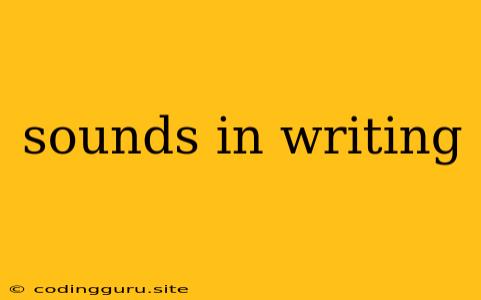Sounds in Writing: How to Make Your Words Sing
Have you ever read a book or story that felt so alive, so vivid, that you could almost hear the characters speaking, feel the wind in your hair, or smell the fresh-baked bread? That's the magic of sounds in writing. It's the art of using words that evoke sensory experiences, pulling the reader into your world and making them truly feel what you're trying to convey.
But how do you achieve this? How do you make your writing sing with the sounds of life? It's not about just throwing in random words that sound nice; it's about a deeper understanding of how language works and how to use it strategically.
The Power of Onomatopoeia
One of the most obvious ways to bring sounds into your writing is through onomatopoeia. This is the use of words that imitate the sounds they represent. Think of "buzz", "sizzle", "crash", "whoosh", and "meow". These words instantly conjure up images in the reader's mind, engaging not just their visual sense but also their auditory one.
Example:
- Instead of writing "The car sped away," try "The car roared away, tires screeching on the asphalt."
The addition of "roared" and "screeching" makes the scene more dynamic and immersive, bringing the reader closer to the action.
Alliteration and Assonance: The Music of Words
Alliteration and assonance are two literary devices that use the repetition of sounds to create a sense of rhythm and harmony. Alliteration is the repetition of consonant sounds at the beginning of words, while assonance is the repetition of vowel sounds within words.
Examples:
- Alliteration: "The silent snow slipped down, softly smothering the land."
- Assonance: "The old man looked up at the clouds, seeing the sun hide behind them."
Used skillfully, alliteration and assonance can add a musical quality to your writing, making it more memorable and pleasing to the ear.
Words as Instruments: Using Imagery to Create Sounds
Beyond the obvious techniques, sounds in writing can also be created through evocative imagery. By using words that describe sounds indirectly, you can paint a sonic picture for your reader.
Example:
Instead of writing "The wind was strong," try "The wind howled through the trees, whistling a mournful tune."
This description uses the sounds of "howled" and "whistling" to convey the strength of the wind, creating a vivid and atmospheric image.
The Impact of Sounds on Meaning
The sounds you choose can also influence the meaning of your writing. Hard, harsh sounds like "g" and "k" often convey aggression or tension. Soft, flowing sounds like "l" and "m" can suggest gentleness, calm, or even mystery.
Example:
- Hard, Harsh Sounds: "The great king crushed his enemies under his foot."
- Soft, Flowing Sounds: "The lullaby sung by the mother sothed the baby to sleep."
By being aware of the impact of sounds on meaning, you can use them to reinforce the emotional tone of your writing and further engage your readers.
Tips for Using Sounds in Your Writing
- Read your work aloud: This is a great way to catch any awkward phrasing or jarring sounds that might distract from your message.
- Experiment with different techniques: Don't be afraid to try different combinations of onomatopoeia, alliteration, assonance, and imagery.
- Be mindful of context: The sounds you choose should fit the tone and style of your writing. Don't use harsh sounds in a poem about love, for example.
- Don't overdo it: Too much repetition of any one technique can be distracting. Use sounds sparingly and strategically to create the desired effect.
Conclusion
Sounds in writing are a powerful tool for engaging your readers and making your writing more memorable and impactful. By understanding how to use language to evoke sensory experiences, you can create a richer, more immersive experience for your audience. So, listen to your words, experiment with different sounds, and let your writing truly sing!
